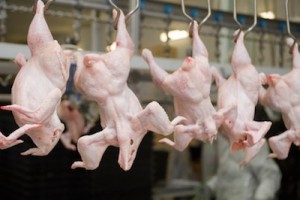Food & Water Watch has released information about problems with a chicken processing plant that is part of the HACCP-based Inspection Models Project (HIMP) that the USDA is promoting as a modernization of poultry inspection. That corporation owns two plants; one has a full staff of USDA FSIS inspectors; the other is privatized, where most of the inspection is turned over to company employees.
The privatized HIMP plant has been upgraded in several ways in the last few years. Walls were repainted, floors cleaned, and slaughter line speeds reduced, even though HIMP calls for increasing those speeds from 140 to 175 birds per minute. Whenever government officials have asked to visit other HIMP plants, FSIS has refused. The George’s Chicken plant in Edinburg, Virginia is a “showcase” plant.
 But when the Government Accountability Office (GAO) studied HIMP in 2013, analysts visited other HIMP plants and found that data to support the changeover to HIMP was lacking. In addition, during a December 2013 tour of that plant, a veterinarian who was on the tour spotted a problem.
But when the Government Accountability Office (GAO) studied HIMP in 2013, analysts visited other HIMP plants and found that data to support the changeover to HIMP was lacking. In addition, during a December 2013 tour of that plant, a veterinarian who was on the tour spotted a problem.
An employee who was inspecting the line saw an issue with a carcass, but it was moving too fast for her to solve the problem and remove the carcass as it moved past. She had to chase the carcass down the slaughter line. Meanwhile, hundreds of chickens went past her work station without being inspected.
A congressional staffer asked FSIS Administrator Alfred Almanza about this event, and he said, “Yeah, they should have stopped the line.” But it wasn’t stopped.
The plant has also been responsible for polluting a local stream. It was cited several times by the Virginia Department of Environmental Quality for “excessive discharges of ammonia, oil, phosphorus, and nitrogen into Stony Creek” which is part of the Potomac River Basin. This is in spite of the HIMP model excluding plants from environmental impact statements. FSIS claims that increasing line speeds makes slaughter more efficient and would not lead to increased pollution. That claim is now questionable.
You can send a message to Secretary Vilsack and President Obama, asking them to end HIMP by visiting the Food & Water Watch web site.




